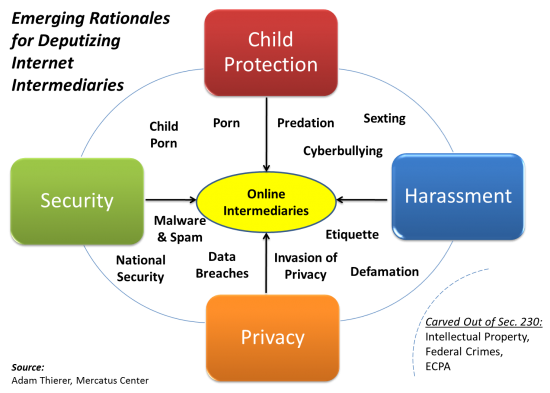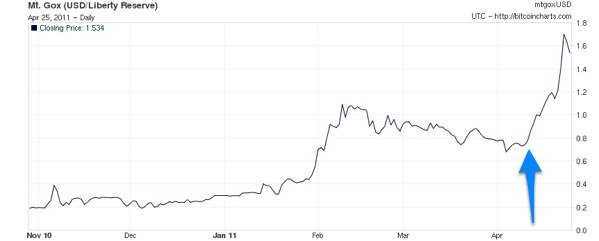One of my favorite topics lately has been the challenges faced by information control regimes. Jerry Brito and I are writing a big paper on this issue right now. Part of the story we tell is that the sheer scale / volume of modern information flows is becoming so overwhelming that it raises practical questions about just how effective any info control regime can be. [See our recent essays on the topic: 1, 2, 3, 4, 5.] As we continue our research, we’ve been attempting to unearth some good metrics / factoids to help tell this story. It’s challenging because there aren’t many consistent data sets depicting online data growth over time and some of the best anecdotes from key digital companies are only released sporadically. Anyway, I’d love to hear from others about good metrics and data sets that we should be examining. In the meantime, here are a few fun facts I’ve unearthed in my research so far. Please let me know if more recent data is available. [Note: Last updated 7/18/11]
- Facebook: users submit around 650,000 comments on the 100 million pieces of content served up every minute on its site.[1] People on Facebook install 20 million applications every day.[2]
- YouTube: every minute, 48 hours of video were uploaded. According to Peter Kafka of The Wall Street Journal, “That’s up 37 percent in the last six months, and 100 percent in the last year. YouTube says the increase comes in part because it’s easier than ever to upload stuff, and in part because YouTube has started embracing lengthy live streaming sessions. YouTube users are now watching more than 3 billion videos a day. That’s up 50 percent from the last year, which is also a huge leap, though the growth rate has declined a bit: Last year, views doubled from a billion a day to two billion in six months.”[3]
- eBay is now the world’s largest online marketplace with more than 90 million active users globally and $60 billion in transactions annually, or $2,000 every second.[4]
- Google: 34,000 searches per second (2 million per minute; 121 million per hour; 3 billion per day; 88 billion per month).[5]
- Twitter already has 300 million users producing 140 million Tweets a day, which adds up to a billion Tweets every 8 days[6] (@ 1,600 Tweets per second) “On the first day Twitter was made available to the public, 224 tweets were sent. Today, that number of updates are posted at least 10 times a second.”[7]
- Apple: more than 10 billion apps have been downloaded from its App Store by customers in over 77 countries.[8] According to Chris Burns of SlashGear, “Currently it appears that another thousand apps are downloaded every 9 seconds in the Android Marketplace while every 3 seconds another 1,000 apps are downloaded in the App Store.”
- Yelp: as of July 2011 the site hosted over 18 million user reviews.[9]
- Wikipedia: Every six weeks, there are 10 million edits made to Wikipedia.[10]
- “Humankind shared 65 exabytes of information in 2007, the equivalent of every person in the world sending out the contents of six newspapers every day.”[11]
- Researchers at the San Diego Supercomputer Center at the University of California, San Diego, estimate that, in 2008, the world’s 27 million business servers processed 9.57 zettabytes, or 9,570,000,000,000,000,000,000 bytes of information. This is “the digital equivalent of a 5.6-billion-mile-high stack of books from Earth to Neptune and back to Earth, repeated about 20 times a year.” The study also estimated that enterprise server workloads are doubling about every two years, “which means that by 2024 the world’s enterprise servers will annually process the digital equivalent of a stack of books extending more than 4.37 light-years to Alpha Centauri, our closest neighboring star system in the Milky Way Galaxy.”[12]
- According to Dave Evans, Cisco’s chief futurist and chief technologist for the Cisco Internet Business Solutions Group, about 5 exabytes of unique information were created in 2008. That’s 1 billion DVDs. Fast forward three years and we are creating 1.2 zettabytes, with one zettabyte equal to 1,024 exabytes. “This is the same as every person on Earth tweeting for 100 years, or 125 million years of your favorite one-hour TV show,” says Evans. Our love of high-definition video accounts for much of the increase. By Cisco’s count, 91% of Internet data in 2015 will be video.[13]
[1] Ken Deeter, “Live Commenting: Behind the Scenes,” Facebook.com, February 7, 2011, http://www.facebook.com/note.php?note_id=496077348919.
[4] eBay, “Who We Are,” http://www.ebayinc.com/who
[5] Matt McGee, “By The Numbers: Twitter Vs. Facebook Vs. Google Buzz,” SearchEngineLand, February 23, 2010, http://searchengineland.com/by-the-numbers-twitter-vs-facebook-vs-google-buzz-36709
[6] http://blog.twitter.com/2011/03/happy-birthday-twitter.html Also see: http://blog.twitter.com/2010/02/measuring-tweets.html
[7] Nicholas Jackson, “Infographic: A Look at Twitter’s Explosive Five-Year History,” The Atlantic, July 18, 2011, http://www.theatlantic.com/technology/archive/2011/07/infographic-a-look-at-twitters-explosive-five-year-history/242070
[9] “10 Things You Should Know about Yelp,” Yelp.com, http://www.yelp.com/about [accessed July 18, 2011]
[10] “Wikipedia: Edit Growth Measured in Time between Every 10,000,000th Edit,” http://en.wikipedia.org/wiki/User:Katalaveno/TBE
[11] Martin Hilbert and Priscila Lopez, “The World’s Technological Capacity to Store, Communicate, and Compute Information,” Science, February 10, 2011, http://annenberg.usc.edu/News%20and%20Events/News/110210Hilbert.aspx.
[12] Rex Graham, “Business Information Consumption: 9,570,000,000,000,000,000,000 Bytes per Year,” UC San Diego News Center, April 6, 2011, http://ucsdnews.ucsd.edu/newsrel/general/04-05BusinessInformation.asp.
[13] Julie Bort, “10 Technologies That Will Change the World in the Next 10 Years,” Network World, July 15, 2011, http://m.networkworld.com/news/2011/071511-cisco-futurist.html?page=1






 The Technology Liberation Front is the tech policy blog dedicated to keeping politicians' hands off the 'net and everything else related to technology.
The Technology Liberation Front is the tech policy blog dedicated to keeping politicians' hands off the 'net and everything else related to technology.